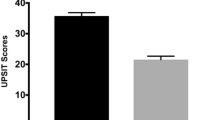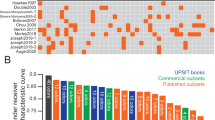Abstract
Although olfactory dysfunction is one of the most well-established prodromal symptoms in Parkinson’s disease (PD), its correlation with clinical disease progression or dopaminergic dysfunction still remains unclear. We here evaluated the association of striatal dopamine metabolism and olfactory function in a homogenous cohort of 30 patients with early untreated de novo PD. Striatal dopamine metabolism was assessed by the extended 18Fluorodopa PET scanning protocol to measure 18Fluorodopa uptake (Kocc) and the effective dopamine distribution volume ratio (EDVR) as the inverse of dopamine turnover. Olfactory function was estimated by the “Sniffin’ Sticks” test including odor threshold (T), discrimination (D) and identification (I) assessment. We detected moderate correlations of the EDVR in the posterior putamen with the TDI composite score (r = 0.412; p = 0.024; Pearson’s correlation test) and the odor identification score (r = 0.444; p = 0.014). These correlations were confirmed by multivariate regression analyses using age, sex, symptom duration and disease severity as measured by UPDRSIII motor score as candidate covariates. No other associations were observed between olfaction measures and Kocc and EDVR in all striatal regions. Together, olfactory dysfunction in early PD is not correlated with striatal 18Fluorodopa uptake as a measure for dopaminergic degeneration, but with putaminal dopamine turnover as a marker for dopaminergic presynaptic compensatory processes in early PD. These results should be treated as hypothesis generating and require confirmation by larger multicenter studies.

Similar content being viewed by others
References
Berendse HW, Roos DS, Raijmakers P, Doty RL (2011) Motor and non-motor correlates of olfactory dysfunction in Parkinson's disease. J Neurol Sci 310(1–2):21–24
Bohnen NI, Gedela S, Kuwabara H, Constantine GM, Mathis CA, Studenski SA, Moore RY (2007) Selective hyposmia and nigrostriatal dopaminergic denervation in Parkinson's disease. J Neurol 254(1):84–90
Bohnen NI, Muller ML, Kotagal V, Koeppe RA, Kilbourn MA, Albin RL, Frey KA (2010) Olfactory dysfunction, central cholinergic integrity and cognitive impairment in Parkinson's disease. Brain 133(Pt 6):1747–1754
Deeb J, Shah M, Muhammed N, Gunasekera R, Gannon K, Findley LJ, Hawkes CH (2010) A basic smell test is as sensitive as a dopamine transporter scan: comparison of olfaction, taste and DaTSCAN in the diagnosis of Parkinson's disease. QJM 103(12):941–952
Doty RL, Deems DA, Stellar S (1988) Olfactory dysfunction in Parkinsonism: a general deficit unrelated to neurologic signs, disease stage, or disease duration. Neurology 38(8):1237–1244
Fahn S, Elton RL, Committee UD (1987) The Unified Parkinson’s Disease Rating Scale. In: Fahn S, Marsden CD, Calne DB (eds) Recent developments in Parkinson’s disease., vol 2. Macmillan Healthcare Information, Florham Park, pp 153–163, 293–304
Georgiopoulos C, Davidsson A, Engstrom M, Larsson EM, Zachrisson H, Dizdar N (2015) The diagnostic value of dopamine transporter imaging and olfactory testing in patients with parkinsonian syndromes. J Neurol 262(9):2154–2163
Goldstein DS, Holmes C, Bentho O, Sato T, Moak J, Sharabi Y, Imrich R, Conant S, Eldadah BA (2008) Biomarkers to detect central dopamine deficiency and distinguish Parkinson disease from multiple system atrophy. Parkinsonism Relat Disord 14(8):600–607
Goldstein DS, Sewell L, Holmes C (2010) Association of anosmia with autonomic failure in Parkinson disease. Neurology 74(3):245–251
Haehner A, Boesveldt S, Berendse HW, Mackay-Sim A, Fleischmann J, Silburn PA, Johnston AN, Mellick GD, Herting B, Reichmann H, Hummel T (2009) Prevalence of smell loss in Parkinson's disease–a multicenter study. Parkinsonism Relat Disord 15(7):490–494
Hahner A, Maboshe W, Baptista RB, Storch A, Reichmann H, Hummel T (2013) Selective hyposmia in Parkinson's disease? J Neurol 260(12):3158–3160
Hawkes CH, Shephard BC, Daniel SE (1997) Olfactory dysfunction in Parkinson's disease. J Neurol Neurosurg Psychiatry 62(5):436–446
Herting B, Schulze S, Reichmann H, Haehner A, Hummel T (2008) A longitudinal study of olfactory function in patients with idiopathic Parkinson's disease. J Neurol 255(3):367–370
Hoehn MM, Yahr MD (1967) Parkinsonism: onset, progression and mortality. Neurology 17(5):427–442
Hughes AJ, Daniel SE, Kilford L, Lees AJ (1992) Accuracy of clinical diagnosis of idiopathic Parkinson's disease: a clinico-pathological study of 100 cases. J Neurol Neurosurg Psychiatry 55(3):181–184
Hummel T, Sekinger B, Wolf SR, Pauli E, Kobal G (1997) 'Sniffin' sticks': olfactory performance assessed by the combined testing of odor identification, odor discrimination and olfactory threshold. Chem Senses 22(1):39–52
Hummel T, Kobal G, Gudziol H, Mackay-Sim A (2007) Normative data for the "Sniffin' Sticks" including tests of odor identification, odor discrimination, and olfactory thresholds: an upgrade based on a group of more than 3,000 subjects. Eur Arch Otorhinolaryngol 264(3):237–243
Jakobson Mo S, Axelsson J, Jonasson L, Larsson A, Ogren MJ, Ogren M, Varrone A, Eriksson L, Backstrom D, Af Bjerken S, Linder J, Riklund K (2018) Dopamine transporter imaging with [(18)F]FE-PE2I PET and [(123)I]FP-CIT SPECT-a clinical comparison. EJNMMI Res 8(1):100
Jennings D, Siderowf A, Stern M, Seibyl J, Eberly S, Oakes D, Marek K, Investigators P (2014) Imaging prodromal Parkinson disease: the Parkinson Associated Risk Syndrome Study. Neurology 83(19):1739–1746
Lee CS, Samii A, Sossi V, Ruth TJ, Schulzer M, Holden JE, Wudel J, Pal PK, de la Fuente-Fernandez R, Calne DB, Stoessl AJ (2000) In vivo positron emission tomographic evidence for compensatory changes in presynaptic dopaminergic nerve terminals in Parkinson's disease. Ann Neurol 47(4):493–503
Lohle M, Mende J, Wolz M, Beuthien-Baumann B, Oehme L, van den Hoff J, Kotzerke J, Reichmann H, Storch A (2016) Putaminal dopamine turnover in de novo Parkinson disease predicts later motor complications. Neurology 86(3):231–240
Lohle M, Mangone G, Wolz M, Beuthien-Baumann B, Oehme L, van den Hoff J, Kotzerke J, Reichmann H, Corvol JC, Storch A (2018) Functional monoamine oxidase B gene intron 13 polymorphism predicts putaminal dopamine turnover in de novo Parkinson's disease. Mov Disord 33(9):1496–1501
Lohle M, Hermann W, Hausbrand D, Wolz M, Mende J, Beuthien-Baumann B, Oehme L, van den Hoff J, Kotzerke J, Reichmann H, Hermann A, Storch A (2019) Putaminal dopamine turnover in de novo Parkinson's disease predicts later neuropsychiatric fluctuations but not other major health outcomes. J Parkinson's Dis 9:693–704
Noyce AJ, Dickson J, Rees RN, Bestwick JP, Isaias IU, Politis M, Giovannoni G, Warner TT, Lees AJ, Schrag A (2018) Dopamine reuptake transporter-single-photon emission computed tomography and transcranial sonography as imaging markers of prediagnostic Parkinson's disease. Mov Disord 33(3):478–482
Oehme L, Perick M, Beuthien-Baumann B, Wolz M, Storch A, Lohle M, Herting B, Langner J, van den Hoff J, Reichmann H, Kotzerke J (2011) Comparison of dopamine turnover, dopamine influx constant and activity ratio of striatum and occipital brain with (1)(8)F-dopa brain PET in normal controls and patients with Parkinson's disease. Eur J Nucl Med Mol Imaging 38(8):1550–1559
Pak K, Kim K, Lee MJ, Lee JM, Kim BS, Kim SJ, Kim IJ (2018) Correlation between the availability of dopamine transporter and olfactory function in healthy subjects. Eur Radiol 28(4):1756–1760
Pifl C, Hornykiewicz O (2006) Dopamine turnover is upregulated in the caudate/putamen of asymptomatic MPTP-treated rhesus monkeys. Neurochem Int 49(5):519–524
Ross GW, Petrovitch H, Abbott RD, Tanner CM, Popper J, Masaki K, Launer L, White LR (2008) Association of olfactory dysfunction with risk for future Parkinson's disease. Ann Neurol 63(2):167–173
Siderowf A, Newberg A, Chou KL, Lloyd M, Colcher A, Hurtig HI, Stern MB, Doty RL, Mozley PD, Wintering N, Duda JE, Weintraub D, Moberg PJ (2005) [99mTc]TRODAT-1 SPECT imaging correlates with odor identification in early Parkinson disease. Neurology 64(10):1716–1720
Sossi V, Doudet DJ, Holden JE (2001) A reversible tracer analysis approach to the study of effective dopamine turnover. J Cereb Blood Flow Metab 21(4):469–476
Sossi V, Holden JE, de la Fuente-Fernandez R, Ruth TJ, Stoessl AJ (2003) Effect of dopamine loss and the metabolite 3-O-methyl-[18F]fluoro-dopa on the relation between the 18F-fluorodopa tissue input uptake rate constant K occ and the [18F]fluorodopa plasma input uptake rate constant Ki. J Cereb Blood Flow Metab 23(3):301–309
Sossi V, de la Fuente-Fernandez R, Schulzer M, Adams J, Stoessl J (2006) Age-related differences in levodopa dynamics in Parkinson's: implications for motor complications. Brain 129(Pt 4):1050–1058
Sossi V, de la Fuente-Fernandez R, Schulzer M, Troiano AR, Ruth TJ, Stoessl AJ (2007) Dopamine transporter relation to dopamine turnover in Parkinson's disease: a positron emission tomography study. Ann Neurol 62(5):468–474
Sossi V, de la Fuente-Fernandez R, Nandhagopal R, Schulzer M, McKenzie J, Ruth TJ, Aasly JO, Farrer MJ, Wszolek ZK, Stoessl JA (2010) Dopamine turnover increases in asymptomatic LRRK2 mutations carriers. Mov Disord 25(16):2717–2723
Stoessl AJ (2007) Positron emission tomography in premotor Parkinson's disease. Parkinsonism Relat Disord 13(Suppl 3):S421–424
Storch A, Wolz M, Beuthien-Baumann B, Lohle M, Herting B, Schwanebeck U, Oehme L, van den Hoff J, Perick M, Grahlert X, Kotzerke J, Reichmann H (2013) Effects of dopaminergic treatment on striatal dopamine turnover in de novo Parkinson disease. Neurology 80(19):1754–1761
Acknowledgements
The authors are grateful to the patients and their relatives, and the teams of the Movement Disorders Outpatient Centre at Dresden University of Technology, the PET division of the Forschungszentrum Dresden-Rossendorf (FZD) and the Coordination Centre for Clinical Trials at the Technische Universität Dresden.
Funding
The original clinical trial was supported by an unrestricted grant from Pfizer Pharma GmbH, Berlin, Germany. The financial sponsors of the study had no role in the study design, data collection, data analysis, data interpretation, or writing of the report. The corresponding authors had full access to all data in the study and had final responsibility for the decision to submit for publication.
Author information
Authors and Affiliations
Contributions
Dr. ML recruited patients, collected clinical data, analysed and interpreted the data, and critically revised the manuscript. Dr. MW recruited patients, collected clinical data, analysed and interpreted the data, and critically revised the manuscript. Dr. BB-B, Dr. LO and Dr. JH collected and analysed PET data and critically revised the manuscript. Dr. JK contributed to the study design, organized funding, analysed PET data and critically revised the manuscript. Dr. HR contributed to the study design, organized funding and critically revised the manuscript. Dr. AS contributed to the study design, organized funding, recruited patients, collected clinical data, analysed and interpreted the data, and wrote the manuscript.
Corresponding authors
Ethics declarations
Conflict of interest
M. Löhle has received has received honoraria for presentations from Bayer Healthcare and UCB Pharma. Dr. Wolz reports personal fees from Boehringer Ingelheim, Zambon, Valeant, Desitin, TEVA, UCB Pharma, Abbvie, Licher, and Daiichi Sankyo, outside the submitted work. B. Beuthien-Baumann has received honoraria for presentations/lectures from BRACCO and Roche Pharma AG, Basel, Switzerland. Dr. Oehme reports no disclosures. Dr. van den Hoff reports no disclosures. Dr. Kotzerke reports no disclosures. H. Reichmann was acting on advisory boards and gave lectures and received research grants from Bayer Health Care, Boehringer/Ingelheim, Cephalon, Desitin, GlaxoSmithKline, Merck-Serono, Novartis, Orion, Pfizer, Solvay, TEVA/Lundbeck, UCB Pharma, and Valeant. Dr. Storch has received funding from the Deutsche Forschungsgemeinschaft (DFG) and the Helmholtz Association. He received unrestricted research grants from GKC Melbourne, Pfizer, and TEVA Pharma, honoraria for presentations/lectures/consultancies or advisory boards from AbbVie, Bayer Healthcare, Bial, GKC, Grünenthal, UCB, Zambon, Ca, AbbVie, TEVA, Lundbeck, and UCB Pharma, outside the submitted work. He has served on the editorial boards of Stem Cells and Stem Cells International.
Additional information
Publisher's Note
Springer Nature remains neutral with regard to jurisdictional claims in published maps and institutional affiliations.
Electronic supplementary material
Below is the link to the electronic supplementary material.
Rights and permissions
About this article
Cite this article
Löhle, M., Wolz, M., Beuthien-Baumann, B. et al. Olfactory dysfunction correlates with putaminal dopamine turnover in early de novo Parkinson’s disease. J Neural Transm 127, 9–16 (2020). https://doi.org/10.1007/s00702-019-02122-9
Received:
Accepted:
Published:
Issue Date:
DOI: https://doi.org/10.1007/s00702-019-02122-9




